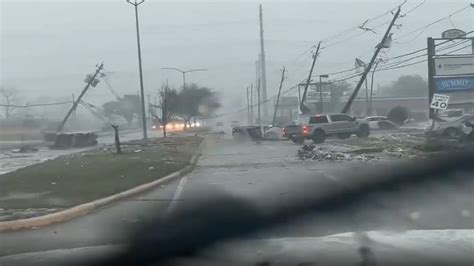
A large tornado tore through North Dakota on Monday, causing significant damage and prompting emergency responses, though initial reports indicate no fatalities or serious injuries.
North Dakota Reels After Large Tornado Causes Widespread Damage
HATTON, N.D. – A powerful tornado ripped through eastern North Dakota on Monday, leaving a trail of destruction in its wake and prompting immediate responses from emergency services. The storm, which struck near the town of Hatton, about 50 miles northwest of Fargo, caused extensive damage to homes, businesses, and infrastructure. Despite the severity of the storm, early reports indicate that there were no fatalities or serious injuries.
According to the National Weather Service (NWS), the tornado touched down around 5:00 PM CDT, rapidly intensifying as it moved eastward. The NWS issued tornado warnings for several counties in the region, urging residents to seek shelter immediately. The warnings proved crucial, as many residents heeded the call and took cover, likely preventing more serious injuries or loss of life.
“We were fortunate that people took the warnings seriously and sought shelter,” said Grand Forks County Sheriff Andy Schneider in a press conference held late Monday. “The damage is significant, but we are incredibly grateful that we haven’t received reports of any fatalities or critical injuries.”
The extent of the damage is still being assessed, but initial reports paint a grim picture. Several homes were completely destroyed, while others sustained significant structural damage. Farmsteads in the area were particularly hard hit, with barns, silos, and other outbuildings flattened by the force of the tornado. Power lines were downed throughout the region, leaving thousands without electricity.
“It looks like a warzone out here,” said local farmer David Olson, whose property was directly in the path of the tornado. “My barn is gone, my equipment shed is gone, and my house has significant damage. I’ve never seen anything like this in my life.”
Emergency responders from across the region were mobilized to assist with search and rescue efforts, as well as damage assessment. Fire departments, ambulance crews, and law enforcement officers worked together to clear debris, search for survivors, and provide medical assistance to those in need. The North Dakota National Guard was also activated to provide support, including security and logistical assistance.
Governor Doug Burgum declared a state of emergency for Grand Forks County and surrounding areas, making state resources available to assist with the recovery efforts. “We are committed to providing whatever assistance is needed to help these communities recover from this devastating storm,” Burgum said in a statement. “We will work closely with local officials and federal agencies to ensure that everyone has the resources they need to rebuild.”
The American Red Cross has established shelters in Hatton and nearby communities to provide temporary housing, food, and other assistance to those who have been displaced by the tornado. Volunteers are also on the ground, helping with cleanup efforts and providing emotional support to residents.
The recovery process is expected to be long and challenging, but residents of North Dakota are known for their resilience and determination. “We’ve been through tough times before, and we’ll get through this too,” said Hatton Mayor Dennis Ostlie. “We’re a strong community, and we’ll support each other every step of the way.”
The National Weather Service is continuing to investigate the tornado to determine its exact strength and path. Preliminary estimates suggest that it was an EF-3 or EF-4 tornado, with winds ranging from 136 to 200 miles per hour. A final determination will be made after a thorough assessment of the damage.
The tornado in North Dakota is a stark reminder of the power of nature and the importance of being prepared for severe weather. Residents are encouraged to stay informed about weather forecasts and to take appropriate precautions when severe weather is predicted. This includes having a plan in place, knowing where to seek shelter, and having an emergency kit ready.
Broader Weather Context and History
The recent tornado in North Dakota is part of a larger pattern of severe weather that has been affecting the Midwest and Great Plains regions of the United States. Increased atmospheric instability, driven by rising temperatures and changes in wind patterns, has led to more frequent and intense storms.
North Dakota, while not traditionally considered part of “Tornado Alley,” has experienced its share of severe weather events. The state’s flat, open terrain provides little resistance to the formation and movement of tornadoes. The clash of warm, moist air from the Gulf of Mexico with cooler, drier air from the north creates the conditions necessary for severe thunderstorms and tornadoes.
Historically, North Dakota has seen several significant tornado outbreaks. One of the most notable events occurred in June 1957 when a series of tornadoes struck the state, causing widespread damage and loss of life. More recently, in June 2000, a powerful tornado struck the town of Lakota, causing extensive damage and injuring several people.
The increasing frequency and intensity of severe weather events in North Dakota and other parts of the country have raised concerns about the impacts of climate change. Scientists have warned that a warming climate could lead to more extreme weather events, including tornadoes, hurricanes, and floods.
The recent tornado in North Dakota underscores the need for continued research into the causes and impacts of severe weather, as well as increased efforts to prepare communities for these events. This includes improving weather forecasting, strengthening building codes, and educating the public about how to stay safe during severe weather.
Impact on Agriculture
North Dakota is a major agricultural state, and the tornado’s impact on the agricultural sector is significant. The destruction of farm buildings, equipment, and crops will have a ripple effect on the local economy. Farmers who have lost their livelihoods will need assistance to rebuild, and the disruption to the food supply chain could lead to higher prices for consumers.
“This is a devastating blow to our farming community,” said North Dakota Agriculture Commissioner Doug Goehring. “These farmers have worked hard all year to produce a crop, and now much of that has been wiped out in an instant. We will do everything we can to support them through this difficult time.”
The loss of livestock is also a major concern. Many farmers in the affected area raise cattle, hogs, and other animals. The tornado scattered livestock across the countryside, and many animals have been injured or killed. The task of rounding up the remaining animals and providing them with food and shelter is a major challenge.
The long-term impact on agriculture in the region will depend on the extent of the damage and the speed of the recovery. It could take years for farmers to rebuild their farms and restore their livelihoods. The state and federal governments will need to provide financial assistance and other support to help them get back on their feet.
Community Resilience and Recovery Efforts
Despite the devastation caused by the tornado, the spirit of the North Dakota community remains strong. Neighbors are helping neighbors, volunteers are pouring in from across the state, and donations are pouring in to support the recovery efforts.
“This is what North Dakota is all about,” said Governor Burgum. “We come together in times of crisis to support each other and to rebuild our communities. We will get through this together.”
The recovery process will be long and challenging, but the people of North Dakota are resilient and determined. With the support of the state, federal government, and the broader community, they will rebuild their homes, their farms, and their lives.
The aftermath of the tornado has also highlighted the importance of community preparedness. Local officials are reviewing their emergency plans and working to improve communication and coordination. Residents are being encouraged to take steps to protect themselves and their families in the event of future severe weather events.
Infrastructure Challenges
Beyond the immediate destruction of homes and businesses, the tornado has severely impacted infrastructure in the affected areas. Downed power lines have left thousands without electricity, and damaged roads and bridges are hampering rescue and recovery efforts. The restoration of these essential services is a top priority.
Utility companies are working around the clock to restore power to the affected areas. Crews are repairing damaged power lines and transformers, and they are bringing in additional resources from other parts of the state and country. However, the damage is extensive, and it could take several days or even weeks to fully restore power to all customers.
The North Dakota Department of Transportation is assessing the damage to roads and bridges. Crews are clearing debris and making temporary repairs to allow emergency vehicles to access the affected areas. More extensive repairs will be needed in the coming weeks and months.
The disruption to infrastructure is also affecting communication services. Phone lines and internet cables have been damaged, making it difficult for residents to communicate with each other and with the outside world. Emergency responders are using satellite phones and other technologies to maintain communication.
Mental Health Support
In the wake of such a traumatic event, mental health support is crucial. Many residents are experiencing stress, anxiety, and grief. It’s essential to provide them with the resources they need to cope with these emotions and to begin the healing process.
Mental health professionals are on the ground in North Dakota, providing counseling and support to residents. The American Red Cross and other organizations are also offering emotional support services.
“It’s important to remember that it’s okay to feel overwhelmed or scared after something like this,” said Dr. Sarah Jones, a psychologist with the North Dakota Department of Health. “It’s normal to have strong emotions, and it’s important to seek help if you’re struggling.”
The long-term mental health impacts of the tornado will need to be monitored. Residents may experience post-traumatic stress disorder (PTSD) or other mental health problems. It’s essential to provide ongoing support and resources to help them recover.
Insurance and Financial Assistance
Navigating the insurance claims process is a major challenge for many residents who have been affected by the tornado. Insurance companies are working to process claims as quickly as possible, but the process can be complex and confusing.
The North Dakota Insurance Department is providing assistance to residents who have questions about their insurance policies. The department has set up a hotline to answer questions and to provide guidance on filing claims.
In addition to insurance coverage, residents may also be eligible for financial assistance from the state and federal governments. The Federal Emergency Management Agency (FEMA) is assessing the damage and will determine whether federal assistance is available.
The process of applying for and receiving financial assistance can be daunting. Local officials and community organizations are providing assistance to residents who need help navigating the process.
Future Preparedness and Mitigation
The tornado in North Dakota serves as a reminder of the importance of being prepared for severe weather events. Local officials and residents are taking steps to improve preparedness and mitigation efforts.
This includes reviewing emergency plans, strengthening building codes, and educating the public about how to stay safe during severe weather. Residents are also being encouraged to purchase insurance coverage to protect their homes and businesses.
The National Weather Service is working to improve its forecasting capabilities and to provide more timely and accurate warnings. The agency is also conducting research to better understand the causes and impacts of severe weather events.
By taking these steps, communities in North Dakota can reduce the risk of damage and injury from future severe weather events.
FAQ: North Dakota Tornado
Q1: Were there any fatalities or serious injuries from the North Dakota tornado?
A1: According to initial reports, there were no fatalities or serious injuries resulting from the tornado that struck eastern North Dakota on Monday. Grand Forks County Sheriff Andy Schneider confirmed that the fact that people heeded warnings and sought shelter likely prevented more serious outcomes.
Q2: What is the estimated strength of the tornado that hit North Dakota?
A2: The National Weather Service is still investigating to determine the tornado’s exact strength. However, preliminary estimates suggest it was an EF-3 or EF-4 tornado, with wind speeds ranging from 136 to 200 miles per hour. A final determination will be made after a thorough damage assessment.
Q3: What areas were most affected by the tornado?
A3: The tornado primarily affected areas near the town of Hatton, which is located approximately 50 miles northwest of Fargo. Grand Forks County and surrounding areas experienced significant damage to homes, businesses, and infrastructure, particularly farmsteads.
Q4: What resources are available for residents impacted by the tornado?
A4: Resources available include:
- Emergency responders assisting with search and rescue and damage assessment.
- The North Dakota National Guard providing security and logistical support.
- A state of emergency declaration by Governor Doug Burgum, unlocking state resources.
- American Red Cross shelters in Hatton and nearby communities for temporary housing and support.
- Mental health professionals offering counseling and support services.
- Assistance from the North Dakota Insurance Department for navigating insurance claims.
- Potential financial assistance from the state and federal governments, including FEMA.
Q5: How can I help those affected by the tornado in North Dakota?
A5: You can help by:
- Donating to reputable organizations such as the American Red Cross or other local charities providing disaster relief.
- Volunteering your time to assist with cleanup efforts or other support activities. Contact local volunteer organizations or community centers for opportunities.
- Spreading awareness about the needs of those affected and encouraging others to contribute.
- Supporting local businesses in the affected areas to help them recover and rebuild.
Detailed Analysis and Expanded Context:
The North Dakota tornado event necessitates a deeper examination beyond the immediate aftermath, addressing factors such as disaster response efficacy, long-term economic implications, infrastructure resilience, and the psychological well-being of the affected population.
Disaster Response Effectiveness:
The swift response by emergency services, the North Dakota National Guard, and volunteer organizations played a critical role in mitigating the immediate impact of the tornado. The declaration of a state of emergency by Governor Burgum was crucial for mobilizing state resources and streamlining the coordination of relief efforts. However, a comprehensive assessment of the disaster response is essential to identify areas for improvement in future incidents.
- Communication Systems: The effectiveness of communication systems during the disaster needs to be evaluated. Were warnings disseminated effectively and in a timely manner to all residents? Were there any communication breakdowns between different agencies or between responders and the public? The use of redundant communication systems, such as satellite phones and amateur radio networks, should be explored to ensure reliable communication during emergencies.
- Search and Rescue Operations: The efficiency of search and rescue operations needs to be analyzed. Were there adequate resources and trained personnel to conduct thorough searches of affected areas? Were there any challenges in accessing remote or heavily damaged areas? The use of advanced technologies, such as drones with thermal imaging capabilities, could enhance search and rescue efforts.
- Shelter and Support Services: The adequacy of shelter and support services needs to be assessed. Were there sufficient shelters available to accommodate all displaced residents? Were there adequate supplies of food, water, and medical care? The provision of mental health support services is also crucial in the immediate aftermath of a disaster.
Long-Term Economic Implications:
The tornado’s impact on the North Dakota economy, particularly the agricultural sector, will be significant. The destruction of crops, livestock, and farm infrastructure will have a ripple effect throughout the local economy, affecting farmers, businesses, and consumers. A comprehensive economic recovery plan is needed to address the long-term challenges.
- Agricultural Losses: The extent of agricultural losses needs to be accurately assessed. This includes not only the value of destroyed crops and livestock but also the cost of repairing or replacing damaged farm infrastructure. Government assistance programs, such as crop insurance and disaster relief funds, will be crucial in helping farmers recover.
- Business Interruption: The tornado will disrupt business operations in the affected areas. Businesses may be forced to close temporarily or permanently, leading to job losses and reduced economic activity. Government assistance programs, such as low-interest loans and tax breaks, can help businesses recover.
- Property Values: The tornado will likely have a negative impact on property values in the affected areas. This could make it difficult for residents to sell their homes or businesses and could reduce the tax base for local governments. Government programs to help homeowners repair or rebuild their properties can help stabilize property values.
Infrastructure Resilience:
The tornado exposed vulnerabilities in the region’s infrastructure, particularly its power grid and transportation networks. Strengthening infrastructure resilience is essential to minimize the impact of future disasters.
- Power Grid Hardening: The power grid needs to be hardened to withstand severe weather events. This includes replacing aging infrastructure, burying power lines underground, and installing smart grid technologies that can automatically reroute power around damaged areas.
- Transportation Network Improvements: The transportation network needs to be improved to ensure that emergency responders can access affected areas quickly and efficiently. This includes repairing damaged roads and bridges, building new roads and bridges, and improving traffic management systems.
- Building Codes and Standards: Building codes and standards need to be updated to ensure that buildings are more resistant to wind damage. This includes requiring stronger building materials, improved construction techniques, and the installation of storm shelters.
Psychological Well-being:
The tornado will have a profound impact on the psychological well-being of the affected population. Many residents will experience stress, anxiety, grief, and other mental health problems. Providing adequate mental health support is crucial to help them cope with these challenges and to begin the healing process.
- Mental Health Services: Access to mental health services needs to be expanded. This includes providing more counselors, therapists, and psychiatrists in the affected areas. Telehealth services can also be used to reach residents who live in remote areas or who have difficulty accessing in-person care.
- Community Support Groups: Community support groups can provide a safe and supportive environment for residents to share their experiences and to connect with others who have gone through similar traumas. These groups can be facilitated by mental health professionals or by trained volunteers.
- Public Awareness Campaigns: Public awareness campaigns can help to reduce the stigma associated with mental health problems and to encourage residents to seek help if they are struggling. These campaigns can also provide information about coping strategies and resources.
Climate Change Considerations:
While attributing any single weather event solely to climate change is complex, the increasing frequency and intensity of severe weather events, including tornadoes, are consistent with climate change projections. It is imperative to consider climate change mitigation and adaptation strategies in long-term planning.
- Climate Change Mitigation: Efforts to reduce greenhouse gas emissions are essential to mitigate the long-term impacts of climate change. This includes transitioning to renewable energy sources, improving energy efficiency, and reducing deforestation.
- Climate Change Adaptation: Communities need to adapt to the changing climate by taking steps to reduce their vulnerability to extreme weather events. This includes strengthening infrastructure, improving emergency preparedness, and developing drought-resistant crops.
Community Engagement and Empowerment:
Effective disaster recovery requires active community engagement and empowerment. Residents should be involved in the planning and decision-making processes to ensure that their needs and priorities are addressed.
- Community Forums: Community forums can provide a platform for residents to share their concerns, ideas, and suggestions. These forums can be facilitated by local officials, community organizations, or neutral third parties.
- Resident Surveys: Resident surveys can be used to gather information about the needs and priorities of the community. This information can be used to inform the development of recovery plans and programs.
- Volunteer Opportunities: Providing volunteer opportunities can empower residents to take an active role in the recovery process. This can include participating in cleanup efforts, helping to distribute supplies, or providing support to other residents.
Lessons Learned and Future Preparedness:
The North Dakota tornado provides valuable lessons for improving disaster preparedness and response efforts in other communities. By analyzing the strengths and weaknesses of the response, communities can better prepare for future disasters.
- Emergency Planning: Emergency plans need to be regularly reviewed and updated. These plans should include procedures for warning the public, evacuating residents, providing shelter and support services, and coordinating with different agencies.
- Training and Exercises: Emergency responders need to be adequately trained and equipped to respond to disasters. Regular training exercises can help to ensure that responders are prepared to handle different types of emergencies.
- Public Education: The public needs to be educated about the risks of severe weather and how to stay safe during a disaster. This includes providing information about warning systems, evacuation routes, and shelter locations.
By addressing these factors, North Dakota can not only recover from the recent tornado but also build a more resilient and sustainable future. The collaborative efforts of government agencies, community organizations, and individual residents are essential to achieve this goal.


![Oreo’s [Flavor] So Good, Fans Will Petition to Keep It Forever!](https://duniateknoku.com/wp-content/uploads/2025/06/unnamed-file-867-150x150.jpg)


![Oreo’s [Flavor] So Good, Petition Time? Fans Demand Permanent Cookie!](https://duniateknoku.com/wp-content/uploads/2025/06/unnamed-file-864-150x150.jpg)



